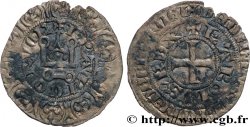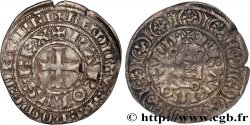正面
正面的文字 [+ KAR]-OLVS (TRÈFLE) REX°, (LA LÉGENDE COMMENCE À 11 HEURES).
正面的说明书 Couronne, un annelet au-dessous.
正面的翻译 (Charles, roi).
背面
背面的文字 + MONETA (ÉTOILE À SIX RAIS) D[VPL]EX, (T ANNELÉ, M ET N ONCIALES).
背面的说明书 Croix fleurdelisée.
背面的翻译 (Monnaie double).
历史细节
CHARLES IV "THE FAIR"
(30/01/1322-01/02/1328)
Born in Clermont-sur-Oise in 1293, last of the sons of Philippe le Bel, Charles IV succeeded his brother Philippe V le Long. This short reign is the prelude to the Hundred Years' War, the third and last century of the long struggle begun at the time of the first crusades between the Capetians and the kings of England, successors of the Conqueror.. Edward II's relations with Charles' predecessors had been rather cordial. But, in 1322, the King of England made it difficult to pay homage to his new suzerain for Aquitaine and Ponthieu. In 1323, Charles IV decided to build a bastide in Saint-Sardos, in the Agenais, a town left to France by the Treaty of Amiens.. The seneschal of Guyenne, Ralph Basset, had the town sacked and the royal officers hanged. In response, on July 1, 1324, the King of France pronounced the confiscation of Guyenne and Ponthieu. Charles de Valois occupied the duchy, except Bordeaux and Bayonne. After a first agreement which made the future Edward III the Duke of Aquitaine, Charles IV occupied Ponthieu and Aquitaine a second time (1327). On March 31, 1327, an agreement was reached with Isabella of France, regent of England: the English possessions were reduced to a thin coastal strip between Saintes and Bayonne.. Charles IV died the following year, without an heir. With him died out the line of direct Capétiens. The crown passed to his closest male relative, Philippe, Count of Valois.








 对产品描述纠错
对产品描述纠错 打印
打印 分享我的选择
分享我的选择 提问
提问 Consign / sell
Consign / sell
 产品介绍
产品介绍











